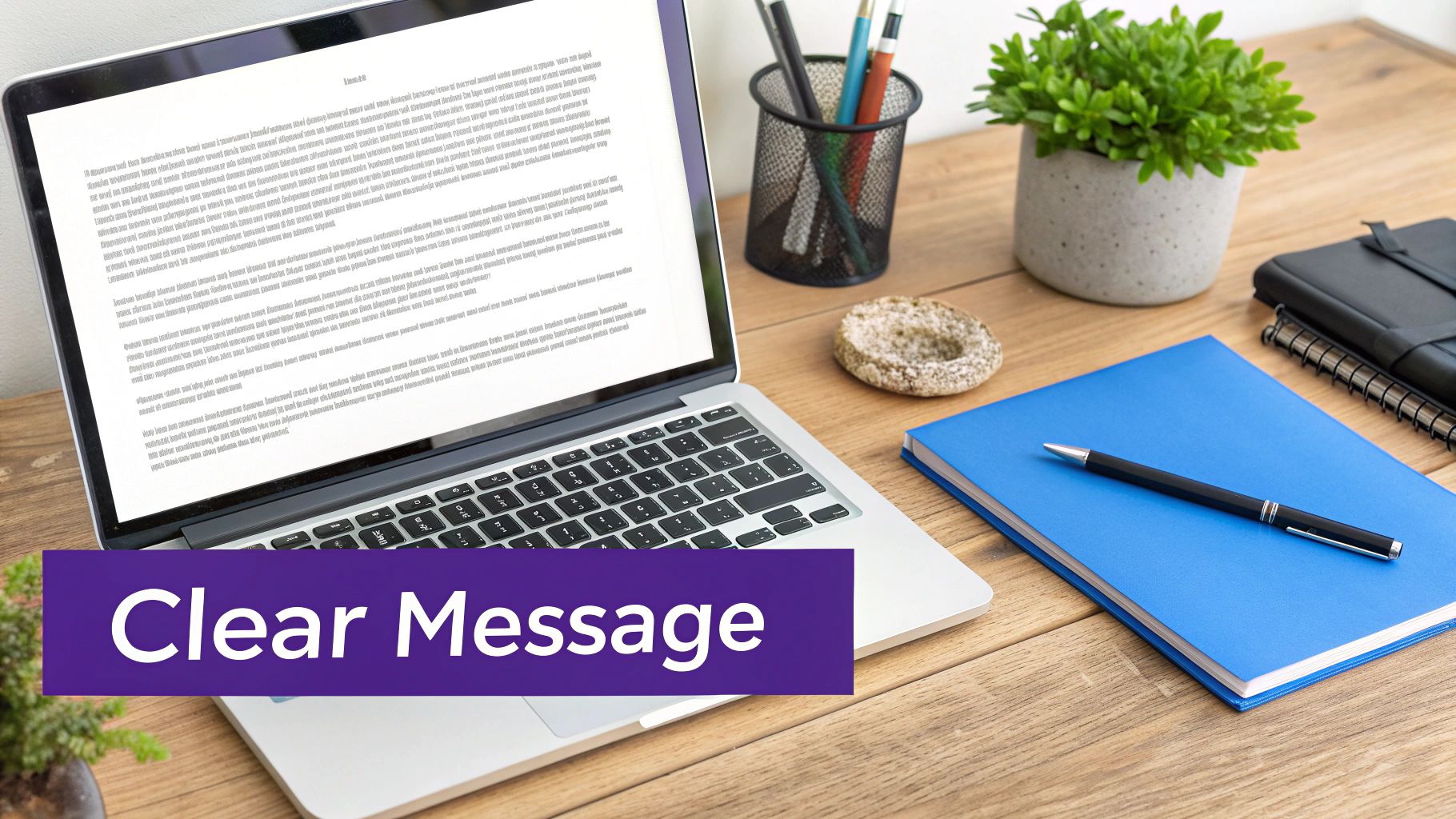Discover Our Sample of Business Testimonial Letter
Explore our sample of business testimonial letter to build trust & boost credibility. Learn proven strategies that turn feedback into sales. Click to discover m
Posted by
The Anatomy of Compelling Business Testimonial Letters
What makes a business testimonial letter truly effective? It's about crafting a narrative that resonates with potential customers and builds trust. It's about understanding persuasive communication and structuring the testimonial for maximum impact. A compelling testimonial provides powerful social proof, validating your claims and influencing buying decisions.
Essential Elements of a Powerful Testimonial
Strong testimonials strategically incorporate several key components. Specific product mentions, for instance, ground the praise in reality, showcasing tangible benefits. Quantifiable results, such as increased sales or improved efficiency, add weight and credibility. Authentic language creates a genuine connection with readers. Finally, a clear and structured format enhances readability and professionalism.
The Power of Authenticity and Structure
Authenticity is paramount. A testimonial that feels forced or generic will lose its persuasive power. This means focusing on genuine customer experiences and using natural language. For inspiration, check out these Top Customer Testimonial Examples to Build Trust. But authenticity alone isn't enough. A well-structured testimonial is easier to read and digest, allowing the key message to stand out. A rambling testimonial, even if positive, can be easily dismissed.
From Weak to Powerful: Transforming Testimonials
Even small phrasing changes can significantly impact a testimonial's effectiveness. Compare "The product is good" to "Using this product saved our team 10 hours per week, allowing us to focus on higher-priority tasks." The second is far more compelling due to its specific details and quantifiable results.
Testimonials significantly impact sales and conversion rates. Including a testimonial on a sales page can increase conversions by up to 34%. Around 71% of customers are more likely to buy after watching a video testimonial. This highlights how effective customer testimonials are in influencing purchase decisions. Find more detailed statistics here. You might also find this helpful: How to write a testimonial.
By focusing on specific details, quantifiable results, and authentic language, you can transform ordinary customer comments into powerful endorsements that drive business growth.

5 High-Impact Business Testimonial Letter Templates
Finding the right words for a business testimonial can feel like a challenge. These five templates, designed for various business situations, offer a strong starting point for gathering compelling testimonials. Each framework highlights key elements that connect with readers and can influence their buying decisions. This offers a useful sample of options for your specific needs.
The Results-Driven Testimonial
This template emphasizes measurable results and return on investment (ROI). It's perfect for showcasing the tangible value your product or service delivers. This approach works particularly well for B2B businesses and service providers where demonstrating clear value is essential.
- Focus: Quantifiable results, data-driven impact
- Key Phrases: "Increased sales by X%", "Reduced costs by Y%", "Improved efficiency by Z%"
- Example: "After implementing EndorseFlow, our sales leads increased by 25% in just three months. The platform's automated features saved us valuable time and resources."
The Problem-Resolution Narrative
This template highlights your ability to address specific customer pain points. It tells a story of a challenge overcome, making your solution relatable and effective. This narrative style is especially powerful when you're offering solutions to complex issues.
- Focus: Addressing pain points, demonstrating solutions
- Key Phrases: "Solved our biggest challenge," "Eliminated the hassle of...", "Made it possible to..."
- Example: "We struggled with gathering client testimonials until we found EndorseFlow. The platform streamlined the entire process, making it easy to collect powerful endorsements."
The Relationship-Focused Endorsement
This template emphasizes the positive working relationship you’ve developed with a client. It showcases the quality of your partnership, building trust and credibility. This template is an excellent option for service-based businesses that prioritize strong client relationships.
- Focus: Partnership, collaboration, positive experience
- Key Phrases: "Exceptional customer service," "True partners in our success," "Always go the extra mile"
- Example: "The EndorseFlow team has been incredibly supportive. They’re not just a vendor; they’re a true partner invested in our growth."
The Expertise Showcase
This template centers on your specialized skills and knowledge. It's ideal for demonstrating your authority within a specific field. This approach works particularly well for consultants, agencies, and other expertise-driven businesses.
- Focus: Demonstrating skill, specialized knowledge, thought leadership
- Key Phrases: "Deep understanding of our industry," "Unmatched expertise," "Invaluable insights"
- Example: "EndorseFlow’s team possesses a deep understanding of social media marketing. Their guidance has been invaluable in optimizing our online presence."
The Transformation Story
This template tells a compelling before-and-after story. It illustrates the positive impact your product or service has had on a client. This approach is especially effective for showcasing dramatic improvements or significant changes.
- Focus: Before and after, impactful change, progress
- Key Phrases: "Transformed our business," "Completely changed the way we…," "Never thought it was possible to..."
- Example: "Before EndorseFlow, our social media presence was inconsistent. Now, we have a steady stream of engaging content that attracts new customers."
The following table summarizes the key features and uses of each template:
Business Testimonial Letter Templates Comparison: A comparison of different testimonial letter templates and their best use cases for various business contexts.
| Template Type | Best Used For | Key Elements | Average Length | Example Phrases |
|---|---|---|---|---|
| Results-Driven | B2B, Service Providers | Quantifiable data, ROI | Short to Medium | Increased sales, Reduced costs |
| Problem-Resolution | Complex Solutions | Challenge/Solution narrative | Medium | Solved our problem, Eliminated the hassle |
| Relationship-Focused | Service-Based Businesses | Partnership, Positive Experience | Short to Medium | Exceptional service, True partners |
| Expertise Showcase | Consultants, Agencies | Specialized knowledge, Authority | Medium | Deep understanding, Invaluable insights |
| Transformation Story | Dramatic Improvements | Before & After, Impactful Change | Medium to Long | Transformed our business, Completely changed the way |
These templates provide a starting point and should be adapted to reflect your unique needs and industry. Using these frameworks can help you gather compelling testimonials that build credibility and drive business growth. A strong testimonial is a valuable asset in your marketing toolkit.
The Art of Requesting Powerful Testimonial Letters
Securing strong testimonials begins with asking the right questions at the right moment. Timing is everything. Think about reaching out after successfully delivering a product or at a peak moment in the customer journey. This is when positive feelings are strongest and customers are most receptive.
Mastering the Timing and Approach
Understanding customer psychology is essential to increasing positive responses. For instance, a customer who just experienced a big win using your product is much more likely to provide a glowing testimonial than someone who hasn't interacted with your brand lately. You might be interested in: How to ask for testimonials.
Additionally, providing clear and concise instructions can greatly improve the quality of the testimonials you receive. Instead of simply asking for a testimonial, guide clients with specific questions. This helps them express their experiences and provide more detailed and powerful responses.
Scripts for Effective Communication
Having pre-written scripts can streamline the process of requesting testimonials. These scripts should be adaptable for different channels, including email, phone, and in-person conversations.
-
Email: "We're delighted you're enjoying [product name]. Would you be willing to share your experience in a brief testimonial? It would be incredibly helpful. To help you get started, could you tell us about the biggest challenge you faced before using [product name] and how our solution helped?"
-
Phone: "Hi [customer name], we're thrilled to hear about your positive experience with [product name]. We're gathering customer stories and would be honored to feature yours. Would you be open to sharing a few words about your experience?"
-
In-person: "It's great to see you, [customer name]. Your success with [product name] is inspiring! We're always looking to share customer success stories. Would you be willing to share a quick testimonial about your experience?"
Overcoming Hesitation and Building Confidence
Many businesses hesitate to ask for testimonials, worried about rejection or feeling like they're bothering their clients. However, testimonials are a potent form of social proof that can significantly influence your business. In fact, approximately 92% of B2B buyers are more inclined to purchase after reading a trusted review. Surprisingly, only about one in five B2B companies actively seek testimonials. This presents a real opportunity. Moreover, 51% of business buyers rely on personal recommendations, and compelling testimonials can increase sales by 37%. Learn more about B2B testimonial templates.
By understanding the psychology behind testimonials and putting effective strategies into practice, you can conquer hesitation, build confidence, and gather convincing endorsements that boost business growth.

Formatting Testimonial Letters for Maximum Persuasion
Your testimonial's content is key, but its presentation matters just as much. The visual aspects of a testimonial significantly influence its persuasiveness. This section explores how formatting affects readers across different platforms. Before sending out testimonials, check out tips on how to get customer testimonials.
Structural Components that Enhance Credibility
Certain design elements boost a testimonial's credibility. A professional letterhead, for instance, immediately adds legitimacy. Signature placement also plays a role. A handwritten signature below the text adds a personal touch, reinforcing authenticity. Visual cues like a company logo or a professional headshot alongside the testimonial can further enhance trustworthiness.
Platform-Specific Formatting Considerations
The ideal format varies depending on the platform. A testimonial carousel on a website might prioritize brevity and strong visuals. However, a detailed testimonial in a formal business proposal might benefit from more thorough formatting, including contact information and company affiliation.
Visual Hierarchy and Attention Direction
Subtle formatting choices make a difference. Highlighting key metrics or results in bold draws the reader's attention. Headings and bullet points improve readability in longer testimonials. It's crucial to strike a balance between professionalism and genuine authenticity. Overly stylized testimonials can appear artificial, reducing their impact.
Maximizing Psychological Impact through Formatting
Visual cues influence our perceptions. Clean, professionally formatted testimonials convey credibility and trustworthiness. Using high-quality images or videos with written testimonials can strengthen their message. These principles ensure your testimonials are not only compelling but also resonate with your audience. Effective formatting maximizes the psychological impact of your testimonials, boosting their persuasiveness and influencing customer decisions.
The Evolution of Testimonial Letters in Digital Marketing

The way businesses use testimonials has undergone a significant transformation. What were once simple letters of recommendation are now dynamic tools for building trust and driving sales. This evolution reflects the changing ways consumers interact with information online, with a growing preference for engaging and easily digestible content.
From Static Text to Dynamic Social Proof
Traditionally, testimonials were primarily static text, often presented as printed letters or quotes on a website. Modern marketing, however, demands more dynamic forms of social proof. This is where platforms like EndorseFlow are making a difference, enabling businesses to collect and showcase testimonials in more engaging formats.
Video testimonials, for instance, have become incredibly popular. They offer a more personal and relatable way for customers to connect with a brand. This shift toward richer media reflects the demand for authenticity and connection in today's marketing landscape.
Historically, using testimonials has evolved alongside technological advancements. Video testimonials, in particular, have seen remarkable growth, with 72% of marketers reporting a return on investment (ROI) between 50% and 500%. This success is even more pronounced in larger businesses, where 78% achieve an ROI of at least 100%.
The increasing use of video highlights the changing ways businesses present testimonials. Compared to written reviews, video testimonials offer a more engaging and personal form of social proof, making them a key element in modern marketing strategies. With only 9% of B2B buyers trusting vendor content, testimonials are crucial for building trust and credibility, especially on platforms like LinkedIn and other social media channels. Learn more about the impact of testimonials here.
Emerging Technologies and Testimonial Collection
New technologies are reshaping how testimonials are collected and displayed. AI-powered tools, for example, can assist businesses in generating testimonial requests and analyzing customer feedback. Testimonial aggregation platforms streamline the process of gathering endorsements from various sources and showcasing them effectively. These advancements empower businesses to manage and utilize customer feedback more efficiently.
Integrating Testimonials Throughout the Customer Journey
Smart businesses are strategically integrating testimonials throughout the customer journey. This includes featuring them on landing pages, product pages, and even within email marketing campaigns.
By strategically placing testimonials at key touchpoints, companies can reinforce trust and encourage conversions. This approach demonstrates a commitment to customer satisfaction and builds confidence in potential buyers. It's about more than just displaying testimonials; it's about weaving them into a cohesive narrative that strengthens brand credibility and drives results.
Legal Frameworks for Ethical Testimonial Letters
Building a successful testimonial program involves more than just gathering positive reviews. It requires a strong commitment to ethical and legal practices. This section explores the legal aspects of using testimonials, ensuring your efforts build trust and avoid legal issues. This includes understanding regulations, obtaining consent, and accurately representing testimonials.
Navigating FTC Endorsement Guidelines and GDPR Compliance
A key concern when using testimonials is adhering to the Federal Trade Commission (FTC) endorsement guidelines. These guidelines mandate transparency regarding any relationships between your business and the endorser. For example, disclosing any free products or services provided in exchange for a testimonial is essential. Testimonials must also reflect honest opinions and real experiences with your product or service. Reviewing sample business testimonial letter templates for compliance is always a good practice. Failing to comply can result in significant penalties, harming your brand's reputation and financial standing.
International regulations, such as the General Data Protection Regulation (GDPR), also influence how you collect and use personal data in testimonials, especially for businesses operating in Europe. GDPR requires explicit consent for data collection and use, emphasizing transparency and data protection. Even outside of Europe, ethical data practices are vital for building customer trust.
Attorney-Reviewed Release Templates and Documentation
Protecting yourself and your customers legally necessitates meticulous documentation. Using attorney-reviewed release templates ensures you have permission to use testimonials across various platforms. These templates should clearly define usage rights, protecting both parties. This formal documentation is fundamental for establishing a legally sound testimonial program.
Maintaining detailed records for each testimonial, including the date of collection, communication methods, and any incentives offered, promotes transparency and simplifies compliance with relevant regulations. This thorough record-keeping creates a clear audit trail, safeguarding your business from potential legal challenges.
Avoiding Legal Pitfalls: Unsubstantiated Claims and Material Connections
Several common mistakes can lead to legal problems with testimonials. Unsubstantiated claims, for example, can cause significant issues. Ensure your testimonials reflect genuine customer experiences and avoid exaggerating results. Reviewing a sample business testimonial letter with exaggerated claims can serve as a valuable lesson. Similarly, failing to disclose any material connections, like financial incentives or free products provided in exchange for testimonials, violates FTC guidelines.
Another frequent error is using testimonials out of context or altering them without consent. Preserving the integrity of the original message is crucial for ethical and legal compliance. Misusing customer information can lead to legal repercussions and severely damage customer relationships and brand reputation.
Ethical Editing and Authenticity
While editing for clarity and conciseness is permissible, maintaining the testimonial’s authenticity is paramount. Avoid altering the core message or taking quotes out of context. Ethical editing improves readability while preserving the customer's genuine sentiment. This transparent approach builds trust and credibility with your audience. By prioritizing ethical practices and carefully navigating the legal landscape, your testimonial program can become a valuable asset for your business. Building trust through transparency forms the foundation of a sustainable and effective testimonial strategy.
Strategic Deployment of Testimonial Letters Across Channels

Deploying testimonials strategically is key to maximizing their impact. Simply placing a business testimonial letter anywhere won't yield the desired results. A carefully planned approach is essential. This means understanding which formats resonate on different platforms and how to repurpose your testimonials effectively. This section explores how to maximize your testimonial's reach and influence. Learn more in our article about How to master your testimonial marketing strategy.
Optimizing Placement for Different Marketing Touchpoints
Different channels require different approaches to testimonial presentation. On your website, short, impactful quotes can work wonders on landing pages, grabbing attention and building initial trust. For product pages, where visitors seek in-depth information, more detailed testimonials featuring case studies can be more effective.
Consider email campaigns. Testimonials can be incorporated into nurture sequences or sales outreach. For nurture campaigns, focus on testimonials that highlight the benefits of your product or service. When crafting sales emails, testimonials that address specific objections or concerns can be highly persuasive.
Social media offers a wealth of opportunities. Visually appealing, short testimonials work well on platforms like Instagram. Longer, narrative-driven testimonials may be more effective on LinkedIn. Consider the difference between organic posts and paid ads. Paid ads might benefit from testimonials focusing on a specific product feature or a limited-time offer.
Repurposing Testimonials for Consistent Messaging
A single testimonial can be transformed into various assets. A powerful quote from a testimonial letter could become a compelling social media graphic. A longer testimonial can be edited into a short, impactful video clip. Repurposing content maximizes the value of each testimonial and ensures a consistent message across all platforms. This strengthens your brand narrative and creates a cohesive customer experience.
A/B Testing: Refining Your Testimonial Presentation
A/B testing helps refine how you present testimonials. This involves experimenting with different formats, placements, and even the testimonials themselves. By analyzing which variations perform best, you can continually optimize your strategy.
For example, you could test two versions of a landing page: one with a text-based testimonial and another with a video testimonial. Tracking conversion rates on each version will reveal which format resonates most with your target audience.
Data-Driven Measurement of Testimonial Effectiveness
Data is crucial for measuring testimonial success. Track key metrics such as conversion rates, website traffic, and social media engagement. This data offers valuable insights into which testimonials are performing best and where they're having the greatest impact.
The following table illustrates how testimonials can be used across different channels:
Testimonial Effectiveness by Marketing Channel Performance data showing how business testimonial letters perform across different marketing channels and formats
| Marketing Channel | Conversion Impact | Best Testimonial Format | Placement Recommendations | Key Metrics to Track |
|---|---|---|---|---|
| Website | High | Short quotes, Case studies | Landing pages, Product pages | Conversion rates, Time on page |
| Email Campaigns | Medium | Benefit-focused, Objection-handling | Nurture sequences, Sales outreach | Open rates, Click-through rates |
| Social Media | Medium to High | Short, visual, Narrative-driven | Organic posts, Paid ads | Engagement, Reach |
| Offline Materials | Medium | Quotes, Short stories | Brochures, Print ads | Brand awareness, Lead generation |
| Sales Presentations | High | Case studies, Success stories | Client meetings, Webinars | Deal closure rates |
This table summarizes the optimal formats and placement strategies for testimonials across various marketing channels. By tracking the suggested key metrics, you can effectively measure the impact of your testimonials and make data-driven decisions to optimize your campaigns.
By understanding the nuances of each platform and using data to inform your strategy, you can ensure your testimonials are working effectively to build trust, influence decisions, and drive business growth. Ready to transform your testimonial process? Try EndorseFlow today and see the difference. Start your free 14-day trial now at https://www.endorseflow.co/.